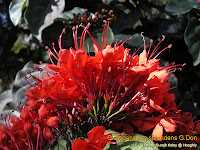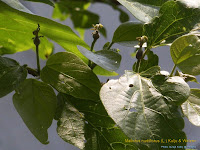




 Bombax ceiba L.
Bombax ceiba L.Family: Malvaceae
Synonyms: Bombax aculeatum L., Bombax ceiba Burm.f., Bombax ceiba var. leiocarpum Robyns, Bombax heptaphyllum Cav., Bombax malabaricum DC., Bombax thorelii Gagnep., Bombax tussacii Urb., Gossampinus malabarica Merr., Gossampinus rubra Buch.-Ham., Gossampinus thorelii Bakh., Melaleuca grandiflora Blanco, Salmalia malabarica (DC.) Schott & Endl
- Common name: Silk Cotton Tree, Kapok Tree Assamese: Dumboil
- Bahas: Randu alas
- Bengali: শিমুল
- Chinese: 木棉花
- Dutch: Indische kapokboom
- Esperanto: Hinda bombako
- Greek: Βόμβαξ ο μαλαβαρικός Vomvax malavarikos
- Hindi: शाल्मली Shalmali, सेमल Semal, शहतूत Shahatoot
- Japanese: キワタ
- Javanese: Randhu alas
- Kannada: Kempuburunga
- Malayalam: Unnamurika, ഇലവ് Ilavu
- Manipuri: Tera
- Marathi: सांवर
- Polski: Wełniak azjatycki
- Portugues: Paineira-vermelha-da-índia
- Punjabi: Simble
- Sanskrit: Shalmali, Moca, Picchila, Raktapuhpa
- Tamil: Sittan, Sanmali, Mullilavu முள்ளிலவு
- Telugu: Buruga బూరుగ
- Thai: งิ้ว (พืช)
- Urdu: سنبل Sembhal
- Vietnamese: Gạo (cây)
Ayurvedic uses: Raktapitta, Vrana, Daha, Yuvanapidika [The Ayurvedic Pharmacopoeia of India Part- I, Volume – III]
Astringent, demulcent, diuretic,aphrodisiac, emetic [Medicinal Plants, Kerala Agricultural University, Aromatic and Medicinal Plants Research Station]
Acne (yuvana Pidika) - [Classical Ayurvedic Prescriptions for Common Diseases]
Astringent, demulcent, diuretic,aphrodisiac, emetic [Medicinal Plants, Kerala Agricultural University, Aromatic and Medicinal Plants Research Station]
Acne (yuvana Pidika) - [Classical Ayurvedic Prescriptions for Common Diseases]
To increase the potency of a man - seedling roots of Bombax ceiba L. (salamali) to chew. To treat the nocturnal pollution [The nocturnal pollutions are, in fact, involuntary loss of semen during sleep. Most often, pollutions occur during the so-called “wet dreams” or erotic dreams] consume the flowers of Bombax ceiba L. (salmali). Rural folk of Assam use leaf to treat infertility; Santals find seedling spermatorrhoea.
Garhwalis and tribes of Dahanu forest use root to treat impotency. The roots are used in dysentery. The gum is useful in dysentery, haemoptysis of pulmonary tuberculosis, burning sensation. The bark is used for healing wounds. Leaves are good for skin eruption. Flowers are good for skin troubles. [Herbal Cures: Traditional Approach]
Young root tips are dried in shade and cooked as a vegetable for patients suffering from impotency. This vegetable is considered to be as good as the leaves of Adansonia digitata to increase the amount of sperm in semen. A half-cup extract of bark and flowers is taken for 3 d to treat sexual diseases such as hydrocele, leucorrhoea and gonorrhoea and to treat an irregular menstrual cycle. [Herbal Drugs: Ethnomedicine to Modern Medicine]
Young roots (Semulmusali)— astringent, (used for dysentery) stimulant, demulcent. Fruits—stimulant, diuretic, expectorant. Used for chronic inflammation of bladder, kidney also for calculus affections. Flowers— astringent and cooling, applied to cutaneous affections. Leaves— anti-inflammatory. Stem bark— demulcent, styptic. Aqueous extract with curd is given for blooddysentery. Bark—paste is applied to skin eruptions, boils, acne, pimples. Seeds used for chickenpox, smallpox, catarrhal affections, chronic cystitis and genitourinary diseases. Gum—astringent, demulcent, styptic. Used for diarrhoea, dysentery, haemoptysis, bleeding piles, menorrhagia, spermatorrhoea. Root and pod—used for the treatment of low vitality and debility.
Chemistry: All parts of the plant gave betasitosterol and its glucosides; seeds, bark and root bark, lupeol; flowers, hentriacontane, hentriacontanol; root bark, in addition, gave -hydroxycadalene. The seed oil yields arachidic, linoleic, myristic, oleic and palmitic acids; seeds contain carotenes, n-hexacosanol, ethylgallate and tocopherols; the gum contains gallic and tannic acids, yields L-arbinose, D-galactose, D-galacturonic acid and D-galactopyranose. Younger roots contain more sugars (arabinose and galactose and peptic substances than the older ones. They contain mucilage, starch, mineralmatter, tannins and non-tannins, along with other constituents. [Indian Medicinal Plants An Illustrated Dictionary]
Various parts of the plant are used in fever, smallpox, rheumatism and leprosy. Bark is demulcent and tonic and is used in menorrhagia, leucorrhoea, diarrhoea, dysentery, boils, acne, pimples and coughs. Roots have stimulant, tonic and aphrodisiac properties and are given in impotency. Roots and barks are emetics. Young fruits are stimulant, expectorant and diuretic and beneficial in calculous affections, chronic inflammation and ulceration of bladder and kidneys. Seed extract is used as oxytocic and gonorrhea. burned infections, dysentery and urinary problems. [Selected Medicinal Plants Of Chittagong Hill Tracts]
Unani uses: Jaryan, Auram [The Unani Pharmacopoeia of India Part – I Volume - V]
53 Published articles of Bombax ceiba












































